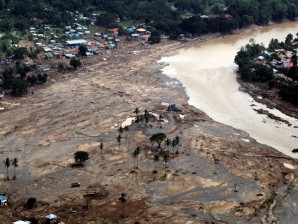Local governments overwhelmed by ‘Sendong’ disaster
ILIGAN CITY—The magnitude of the destruction wrought by Tropical Storm “Sendong” has overwhelmed the disaster response capability of the local governments here and in Cagayan de Oro City.
“This situation is unprecedented,” said Iligan Councilor Ariel Anghay, a former broadcast journalist who voluntarily anchored a special 16-hour daily program with Radyo Mo Nationwide-dxIC on December 17-21 to help respond to the emergency.
Sendong ravaged 21 of Iligan’s 44 barangays (villages), affecting over 45,000 people or almost a fifth of its population.
In the hardest-hit Barangays Upper Hinaplanon, Hinaplanon, Santa Felomina, Mahayahay and Santiago, entire neighborhoods were wiped out.
Some 3,497 families, or almost 16,000 people, are staying in 28 evacuation centers.
Article continues after this advertisementWeak command
Article continues after this advertisementBefore Sendong, the biggest natural disaster that the local government had to cope with was in January 2009, when the Iligan River overflowed and engulfed houses on its path. Big waves battered the coastal communities, displacing some 300 families in five barangays.
The local government’s disaster response capability was no match to the severity of Sendong’s onslaught. During the crucial first few days, the central command center had no dedicated phone line.
A day after the deluge, when displaced residents needed immediate relief, logistical and scheduling issues hampered the distribution of food supplies.
It took about four days for the power supply to be restored in various parts of the city.
And a week after the tragedy, the water supply is still wanting because damaged subtransmission pipes still need repair. Fire trucks of private industries and of the Bureau of Fire Protection have been providing bath and laundry water to evacuation centers.
Muck everywhere
Mud and debris are still heaped under bridges, on trees, and in houses. Many survivors, like those in Bayug Island, believe that their missing kin are buried in the piles of muck.
Deep mud and scattered logs still hamper access to the interior barangays.
For far-flung areas, inaccessibility means hunger. For two days, some 30 families left homeless in Barangay Bonbonon’s Sitio Wago made do with green bananas that they had gathered from the river.
Dignified burial
But despite the gaps in the delivery of service to the flood survivors, the Iligan City government is doing right by the dead. The search and retrieval operations are continuing.
Amid the tragedy, Iligan Mayor Lawrence Cruz has kept his bearings and insisted on providing a dignified burial place even if some corpses had yet to be unidentified.
Responding to a public clamor for the immediate burial of unclaimed corpses in mortuaries, Cruz had apartment-type tombs built at the Palao Public Cemetery. He also ordered the mass production of coffins to address the shortage.
The making of coffins and construction of tombs employed volunteers from among local government workers.
And in the immediate aftermath of the storm, the goodwill of Iligan’s neighbors, such as Bacolod and Kauswagan in Lanao del Norte, and Laguindingan, Initao and Manticao in Misamis Oriental, eased the burden of looking for survivors and recovering the dead.
Help
Cagayan de Oro is also slowly getting back on its feet with continued help from other local governments, Vice Mayor Caesar Ian Acenas said.
On Monday, Maguindanao Governor Esmael Mangudadatu arrived with mobile clinics for a medical mission.
He brought some 3.5 tons of fresh tilapia, a product of his province, and distributed 3,500 food packs, 500 boxes of sardines, and medicines.
Acenas said the focus now was cleaning up the streets of mud and debris.
At Macasandig Elementary School, the social welfare project development officer said “leaders” had been named for each classroom housing a number of families.
“In this way, food distribution is orderly,” Lito Wapin said.
